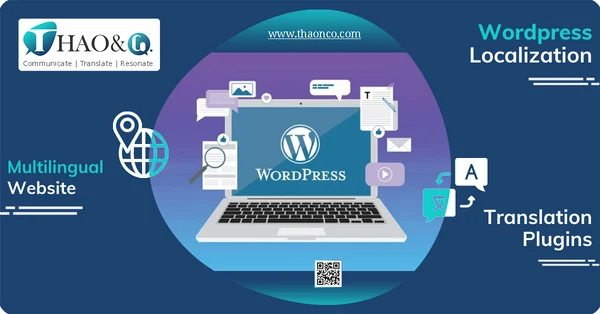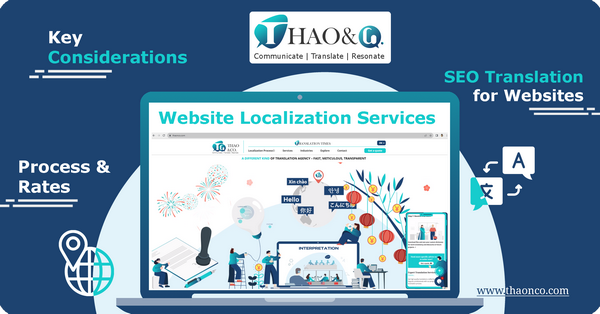WordPress website localization is a popular trend worldwide. With the support of the WordPress source code, building and developing websites has become easier. This is also the topic that Thao & Co. wants to discuss in our article.
WordPress is one of the most popular content management solutions in the world today. Furthermore, WordPress is a free open-source software that allows users to publish blogs or websites. WordPress is built using PHP and the MySQL database management system.
A localized WordPress website is the term for WordPress websites that support multiple languages. With plugins, users can easily set up multilingual functionality for WordPress.
Localization involves translating and adjusting content to conform to the rules and features of the target language. In other words, content localization is not only about translating text. The goal of content localization is to ensure that the translated content is compatible with the target audience and market.
An example of content localization is foreign films being screened in Vietnam. The dialogue of the actors is not only translated into Vietnamese but also adjusted to match the language preferences of the target audience. Thanks to that, the dialogues in the film align with the culture and preferences of the local audience.
When setting up the multilingual feature for WordPress, the role of content localization is crucial. As websites often cover diverse topics in different formats for a variety of people, the localization process can take on many forms.
Translating URLs, SEO titles, meta tags, homepages, subpages, category changes, interface adjustments, images, banners, audio files, symbols, etc. All must ensure alignment with context, interface, and user-friendly functionalities.

Faced with the need to expand market reach, many businesses have started to localize websites. Understanding this, the WordPress development team has researched and created various supporting tools. Below are the steps for installing multilingual feature for WordPress.
Website translation is the process of converting the existing language on a website into a new language. For businesses looking to increase their market presence or gain a foothold in a new region, there are several important considerations to keep in mind. The website translation must be proofread to meet the requirements on SEO keyword research, and localization, and integrated into the CMS system.
All the steps above will help your business procure the best translation. Excellent comprehensibility aside, your website will not only look professional, and viewer-friendly but also achieve high rankings on search engines. This process is relatively complex, requiring businesses to enlist the help of translation services.
After obtaining the translation, choose a plugin to set up multilingual WordPress. There are lots of multilingual plugins nowadays, both free and paid. Each plugin has its own advantages and disadvantages for different needs. Here are some options you can consider:
GTranslate provides optimized features for WordPress website localization. The free version includes support for automated translation with over 100 languages. This plugin has garnered up to 500 thousand installations and received over 3000 five-star ratings.
GTranslate allows users to add a switch button or automatically translate the website based on the language of the user’s browser. In addition, the paid version offers additional features such as editing translations, indexing translated content, translating URLs, and language-specific caching. With $9.99, this is one of the most comprehensive multilingual plugins for WordPress.
Polylang is a widely used plugin with over 700 thousand installations and more than 2000 five-star reviews. The advantage of Polylang is the diverse division between paid and free versions. Users can use the free version with simple features to create a multilingual website.
With €99 per year, Polylang Pro offers enhanced integration with the new Block Editor, language switching in block form, content export/import in XLIFF format, and many other new features. Websites integrated with WooCommerce will require a premium version. Polylang is praised for its user-friendly interface, with each version well-optimized for various needs.
TranslatePress is the quickest way to set up different language versions for a WordPress website. TranslatePress can translate the website directly from the interface and apply changes in real-time. This plugin can help you edit anything on the website, such as the menu bar, buttons, text, and more. Moreover, all features are applicable to WooCommerce, complex interfaces, and website builders.
TranslatePress is a self-hosted GPL translation plugin, which means you can keep the translations forever. Its starting price is just $7.99 per month, and $13 to receive enhanced SEO features, additional translator accounts, automatic user redirection, additional add-ons, and more. This plugin currently has over 300 thousand installations and more than 1000 five-star reviews.
Weglot Translate is a recently emerged multilingual plugin for WordPress localization. This plugin provides all the necessary features to support the creation of a multilingual website. You only need a few minutes to install the plugin, choose automatic translation languages, edit translations, index translated content, add translators, import or export translations, and more.
The only weakness of Weglot is that it charges based on the number of languages and the number of words translated. This can make the cost higher compared to other plugins. However, Weglot remains one of the preferred multilingual plugins. The starting price is 15 Euros per month for one language and 10,000 words.

Besides using a plugin to set up multilingual features for WordPress, you can opt for Custom Integration services. Custom Integration is the process of integrating one or more languages into a website, ensuring that translations are compatible with the website’s interface and functionality.
Unlike automatic integration methods, after the content has been translated and localized, programmers will update it directly in the CMS. Thanks to this, your website can minimize the risks related to interface, user experience, and security. This is the most flexible and comprehensive quality control method currently, trusted and chosen by many businesses.
After choosing the suitable plugin to set up multilingual for WordPress, the next step is to optimize the interface and user experience. There are two popular options: installing automatic redirection or adding a language switch button. Automatic redirection is a method that makes the website switch language based on the user’s browser settings.
Another option that should be prioritized is the language switch button. For WordPress source code, most plugins allow adding a language switch button. Paid plugins may provide customization options, interface changes, or use flags to categorize languages. This way, users accessing the website can choose the preferred language.
Multilingual plugins for WordPress can provide automatic translation. Automatic translation means using tools for translation, such as Google Translate while manual translation allows administrators to edit existing translations or add new translations from external sources.
Automatic translation used to be a popular method for localizing websites to different languages. Its advantages, such as time savings, simplicity, support from many WordPress plugins, and low costs, make automatic translation a worthwhile choice. However, over time, the requirements for translations have increased with additional demands on the optimization of multilingual SEO, user experience, and the professionalism of the website.
That’s why manual translation has regained popularity in place of automatic translation. Manual translation can address almost all the drawbacks of automatic translation. Firstly, in terms of meaning, some words may be misunderstood when translated using tools. Secondly, in terms of the message, Google Translate may struggle to convey messages deeply and powerfully.

Technical factors when setting up multilingual WordPress are also crucial. With manual translation, linguists can research, analyze, and choose SEO keywords to optimize search engine rankings. Moreover, when translating expressions, headlines, slogans, etc., creativity is required, a challenging task for automatic translation.
In summary, if you need a quick, cost-effective bilingual or multilingual version and don’t have specific requirements in terms of communication, or marketing, you can choose automatic translation.
On the contrary, manual translation will be a suitable choice for websites that need to convey a specific message, optimize SEO, and enhance user experience in a new language. Manual translation is highly recommended for multilingual websites like business websites, e-commerce sites, news portals, social networks, and educational platforms.
In response to the growing demand for professional website translation services, Thao & Co. has emerged with the message “It’s all in the words.” In nearly ten years of development, Thao & Co. has collaborated with language experts to serve hundreds of clients from across five continents.
As one of the leading translation agencies, Thao & Co. always strives to provide the best services. Our most popular service is website localization, which supports Custom Integration and Linguistic Review. You will be able to discuss with linguists to clarify the requirements and preferences for the translation.

We have extensive experience in SEO translation with a refined keyword research process to ensure that the translation achieves optimal ranking on Google and other search engines.
In the content localization stage, the language will be adjusted to fit the culture, geography, and people of the target market. Finally, IT experts at Thao & Co. will help you integrate the translation into the website. This ensures a consistent interface, that aligns with the website’s goals with enhanced user experience.
Please visit our Get a Quote page to provide your project details, we will get back to you for detailed consultation within 24 hours.
A properly set up multilingual website will serve to fuel your business’s market expansion. Therefore, setting up WordPress website localization with multilingual plugins is becoming increasingly popular.
To acquire quality translations, it is advisable to opt for manual translations provided by professional agencies. We hope that this article has provided comprehensive answers to any questions you may have. For consultation and support, please contact Thao & Co.